The Palazzo Turchi, also called the Palazzo dei Diavoli, is a castle-like structure located outside the city wall of Siena, near Porta Camollia between Viale Cavour e via Fiorentina.

The Palazzo Turchi, also called the Palazzo dei Diavoli, is a castle-like structure located outside the city wall of Siena, near Porta Camollia between Viale Cavour e via Fiorentina.

The site of this brick fortress house was the site where a combined Florentine and Papal army of Clement VII was defeated by the Sienese in 1526. The tall tower is the element remaining from medieval construction by the Turchi family, perhaps with architect Cecco di Giorgio. [1] The name of Palace of the Devil is quaintly attributed by guides to Siena for a variety of possible reasons. Some claim the site was used for devil worship, others claim only with the help of the Devil could the Sienese triumph over Papal-blessed armies. The present structure owes much to 19th-century reconstructions. [2]

Borghese is the surname of a princely family of Italian noble and papal background, originating as the Borghese or Borghesi in Siena, where they came to prominence in the 13th century holding offices under the commune. The head of the family, Marcantonio, moved to Rome in the 16th century and there, following the election (1605) of his son Camillo as Pope Paul V they rose in power and wealth. They were one of the leading families of the Black Nobility and maintain close ties to the Vatican.

The Torre del Mangia is a tower in Siena, in the Tuscany region of Italy. Built in 1338-1348, it is located in the Piazza del Campo, Siena's premier square, adjacent to the Palazzo Pubblico. When built it was one of the tallest secular towers in medieval Italy. At 102 m, it is second tallest after Cremona's Torrazzo, the Asinelli tower in Bologna at 97 m being third.

Piazza del Campo is the main public space of the historic center of Siena, Tuscany, Italy and is regarded as one of Europe's greatest medieval squares. It is renowned worldwide for its beauty and architectural integrity. The Palazzo Pubblico and its Torre del Mangia, as well as various palazzi signorili surround the shell-shaped piazza. At the northwest edge is the Fonte Gaia.

Pienza is a town and comune in the province of Siena, Tuscany, in the historical region of Val d'Orcia. Situated between the towns of Montepulciano and Montalcino, it is considered the "touchstone of Renaissance urbanism".

The Republic of Siena was a historic state consisting of the city of Siena and its surrounding territory in Tuscany, central Italy. It existed for over 400 years, from 1125 to 1555. During its existence, it gradually expanded throughout southern Tuscany becoming one of the major powers of the Middle Ages, and one of the most important commercial, financial and artistic centers in Europe.

San Raimondo, also called San Raimondo al Refugio, is a Baroque style, Roman Catholic church located on the intersection of Via del Refugio and Via di Fiera Vecchia, in the Terzo of Camollia of the city of Siena, region of Tuscany, Italy. The church is dedicated to St Raymond of Pennafort.

The Palazzo Chigi-Saracini is a Gothic urban palace on the Via di Città in the Terzo di Città in central Siena, Tuscany, Italy. In 2014 it housed the Accademia Musicale Chigiana.

Siena is a city in Tuscany, Italy. It is the capital of the province of Siena.

The Pinacoteca Nazionale is a national museum in Siena, Tuscany, Italy. Inaugurated in 1932, it houses especially late medieval and Renaissance paintings from Italian artists. It is housed in the Brigidi and Buonsignori palaces in the city's center: the former, built in the 14th century, it is traditionally identified as the Pannocchieschi family's residence. The Palazzo Bichi-Buonsignori, although built in the 15th century, has a 19th-century neo-medieval façade based on the city's Palazzo Pubblico.

Siena’s Fortezza Medicea is a fort built in the city between 1561 and 1563 on the orders of Duke Cosimo, a few years before he became the first Grand Duke of Tuscany.
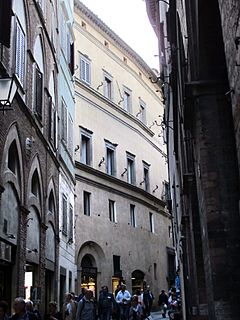
Palazzo del Magnifico, also known as Palazzo Petrucci, built as the residence of Pandolfo Petrucci, is located in Siena on Piazza San Giovanni at the corner of Via dei Pellegrini.
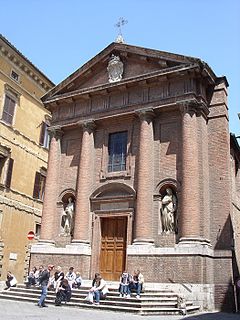
San Cristoforo is a Roman Catholic church located on Piazza Tolomei in the Northern Terzo di Camollia and contrada of Civetta in the city of Siena, region of Tuscany, Italy. Across the piazza from the church is the Palazzo Tolomei, one of the oldest buildings in the city. The Tolomei for many years were associated with the church.

The Palazzo Tolomei is an imposing, Gothic style urban palace, located on Via Banchi di Sopra in the present contrada of Civetta, Terzo di Camollia of the city of Siena, region of Tuscany, Italy.

The Palazzo Spannocchi is a Renaissance style urban palace located on the Piazza Salimbeni, just off Via Banchi di Sopra in the Terzo di Camollia of the city of Siena, region of Tuscany, Italy. The building was associated with an ancient mercantile family of Siena.
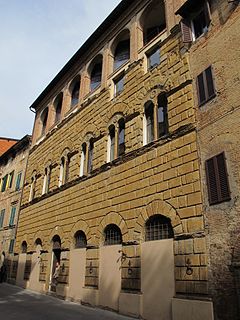
The Palazzo San Galgano is a Renaissance style urban palace located on via Roma number 47, in Terzo Camollia of the city of Siena, region of Tuscany, Italy. The palace is around the corner from the church of San Raimondo.

The Palazzo Arcivescovile or Archbishop's Palace of Siena is the official residence of the archbishop and the offices of the Archdiocese of Siena-Colle di Val d'Elsa-Montalcino. The neo-Gothic architecture building is located adjacent to the Cathedral of Siena.

The Palazzo Celsi Pollini, once also called the Palazzo del Vescovo, is a Renaissance style urban palace in Siena, Italy. It is located on Pian dei Mantellini #39-41, at the corner with Via San Quirico. A 19th-century source refers to the house as Casa Campioni. The main facade faces the campanile of San Niccolò del Carmine.
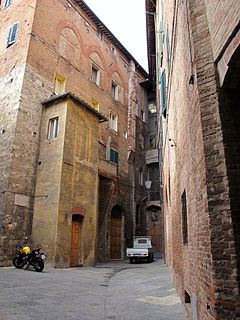
The Castellare degli Ugurgieri is a medieval fortress-house or fortress-palace, erected by the prominent Sienese Ugurgieri family in the 13th century. It is located on an Via Francigena off Piazza Salimbeni, in central Siena, region of Tuscany, Italy. It is behind the Palazzo Bandini Piccolomini. The courtyard is accessible and the building now houses the headquarters and museum of the Contrada della Civetta.
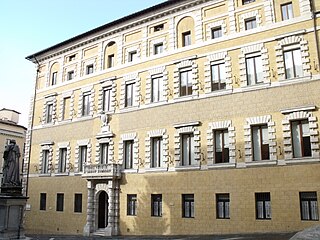
The Piazza Salimbeni is a prominent square in central Siena, Region of Tuscany, Italy. It is notable for still housing the offices of one of the first banking houses in Europe, the Banca Monte dei Paschi di Siena. It is surrounded clockwise starting from north by the following palaces:

The Republic of Siena in its progressive territorial growth saw its borders expanding especially in the territories of southern Tuscany in the current province of Grosseto. The possession of an "access to the sea" by Siena was therefore a natural continuation of its expansionary and commercial policy in the Maremma with the conquest of the ports of Talamone, Porto Ercole and Porto Santo Stefano.